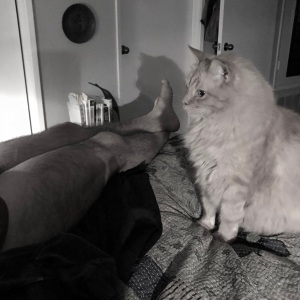The moon woke me this morning. Just like last month’s full moon. Suspended like a prison guard’s searchlight outside my living room window. So bright I can read by its light. That moon. Too stunning to turn away. I watch its stealth decent – soon half gone behind the trees across the way. Meanwhile, grey dawn begins to cast its own soft light through the kitchen window behind me. A reminder that soon there’ll be no time to be distracted by light bouncing from a pock marked rock floating in blue black space. My day is beginning. And in the last few minutes of pre-dawn stillness my task is to put down words to describe what I see and feel.
But that’s impossible because the padded click of Bruce the Cat’s clawed feet across our luxury vinyl plank flooring tickles my ears as he approaches the overstuffed chair where I sit with my laptop resting – appropriately – on my knees. A fresh brewed cup of coffee is on the table to my right.
Bruce the Cat is deaf. These days he compensates for his deafness with meows loud enough to wake the dead. They are meows that after twenty years are beginning to grow rough around the edges – a combination of Screech from Saved by the Bell, Urkel from Family Matters and a two-pack-a-day habit. And as his primary human companion I know what each meow means.
‘Hold me. Love me. Feed me. Pet me. Take me out. Bring me in. Leave me alone.’
Despite a stagger in his step when he first wakes Bruce remains nimble and has no problem hopping onto the arm of the chair. He spends a good five minutes investigating – my computer, my face, my coffee cup – before settling on the sofa to watch the moon with me. Or to take a nap.
I adopted Bruce when he was fourteen-years-old the death of his first human companion. I saw his photo on NextDoor and was smitten by the cheeky look in his eyes and his long ginger coat. My own human companion, Ben, was not a ‘cat person’. But he loved me (miraculously he still does). He said ‘as long as Bruce doesn’t jump on the bed’. Not only was Bruce a senior cat, he was obese. So I said, ‘don’t worry, he’ll never be able to jump on our bed’.
After three days, when Bruce the Cat decided that his new living accommodations were satisfactory, he crawled out from under the couch, sauntered into the bedroom, wiggled his butt to build maximum vertical lift, leapt onto the duvet and fell asleep on Ben’s and my pillows.
From that moment Ben and I knew who was boss. It wasn’t us.
And now, six years later, our lives revolve around Bruce the Cat. We’ve grown accustomed to being covered in cat fur. It’s become second nature to do a visual sweep of the kitchen floor in the morning to make certain there are no horked up hairballs. And we clean Bruce’s litter boxes with the ease and nonchalance of a mother changing a diaper.
Bruce the Cat will be twenty-one in September and I know that means the time Ben and I have left with him is limited.
If I’m being truthful, knowing that Bruce’s best days are behind him, I feel compelled to spend time with him. To keep him nurtured and comfortable. I cook chicken for him and give him bonito flakes as a treat. I don’t like to upset his routine and avoid traumatizing Bruce with cat sitters. So I don’t leave the house for more than a day. And as the sun rises and the moon sets, I put off writing to offer Bruce the cuddles he and I both need. I love Bruce, I love Ben and I love my home. I feel immense gratitude for all three.












